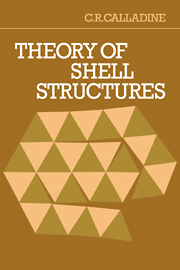Book contents
- Frontmatter
- Contents
- Preface
- List of symbols
- 1 Introduction
- 2 Generalised Hooke's law for an element of a shell
- 3 Cylindrical shells under symmetric loading
- 4 Purely ‘equilibrium’ solutions for shells: the membrane hypothesis
- 5 The geometry of curved surfaces
- 6 Geometry of distortion of curved surfaces
- 7 Displacements of elastic shells stressed according to the membrane hypothesis
- 8 Stretching and bending in cylindrical and nearly-cylindrical shells
- 9 Problems in the behaviour of cylindrical and nearly-cylindrical shells subjected to non-symmetric loading
- 10 Cylindrical shell roofs
- 11 Bending stresses in symmetrically-loaded shells of revolution
- 12 Flexibility of axisymmetric bellows under axial loading
- 13 Curved tubes and pipe-bends
- 14 Buckling of shells: classical analysis
- 15 Buckling of shells: non-classical analysis
- 16 The Brazier effect in the buckling of bent tubes
- 17 Vibration of cylindrical shells
- 18 Shell structures and the theory of plasticity
- Appendices
- Answers to selected problems
- References
- Index
14 - Buckling of shells: classical analysis
Published online by Cambridge University Press: 02 February 2010
- Frontmatter
- Contents
- Preface
- List of symbols
- 1 Introduction
- 2 Generalised Hooke's law for an element of a shell
- 3 Cylindrical shells under symmetric loading
- 4 Purely ‘equilibrium’ solutions for shells: the membrane hypothesis
- 5 The geometry of curved surfaces
- 6 Geometry of distortion of curved surfaces
- 7 Displacements of elastic shells stressed according to the membrane hypothesis
- 8 Stretching and bending in cylindrical and nearly-cylindrical shells
- 9 Problems in the behaviour of cylindrical and nearly-cylindrical shells subjected to non-symmetric loading
- 10 Cylindrical shell roofs
- 11 Bending stresses in symmetrically-loaded shells of revolution
- 12 Flexibility of axisymmetric bellows under axial loading
- 13 Curved tubes and pipe-bends
- 14 Buckling of shells: classical analysis
- 15 Buckling of shells: non-classical analysis
- 16 The Brazier effect in the buckling of bent tubes
- 17 Vibration of cylindrical shells
- 18 Shell structures and the theory of plasticity
- Appendices
- Answers to selected problems
- References
- Index
Summary
Buckling of structures
Buckling is a word which is used to describe a wide range of phenomena in which structures under load cease to act in the primary fashion intended by their designers, but undergo instead an overall change in configuration. Thus a rod which was originally straight, but has bowed laterally under an end-to-end compressive load has buckled; and so has a cylindrical shell, which has crumpled up under the action of the loads applied to it.
The buckling of structures is an important branch of structural mechanics, because buckling often (but not always) leads to failure of structures. It is particularly important in shell structures because it often occurs without any obvious warning, and can have catastrophic effects.
The buckling of shells has been studied intensively for about four decades, and the information now available on the subject is enormous. The aim of this chapter and the two following is to give an introduction to the subject in the simplest possible terms.
The ‘classical’ theory to be described in this chapter is merely an extension into the field of shell structures of what is often described as the ‘Euler’ theory of buckling of simple struts which are initially straight. For some problems in shell buckling this kind of theory is adequate, and well attested by experiment; but for other problems it is inadequate and indeed can be positively misleading.
- Type
- Chapter
- Information
- Theory of Shell Structures , pp. 473 - 549Publisher: Cambridge University PressPrint publication year: 1983
- 1
- Cited by

